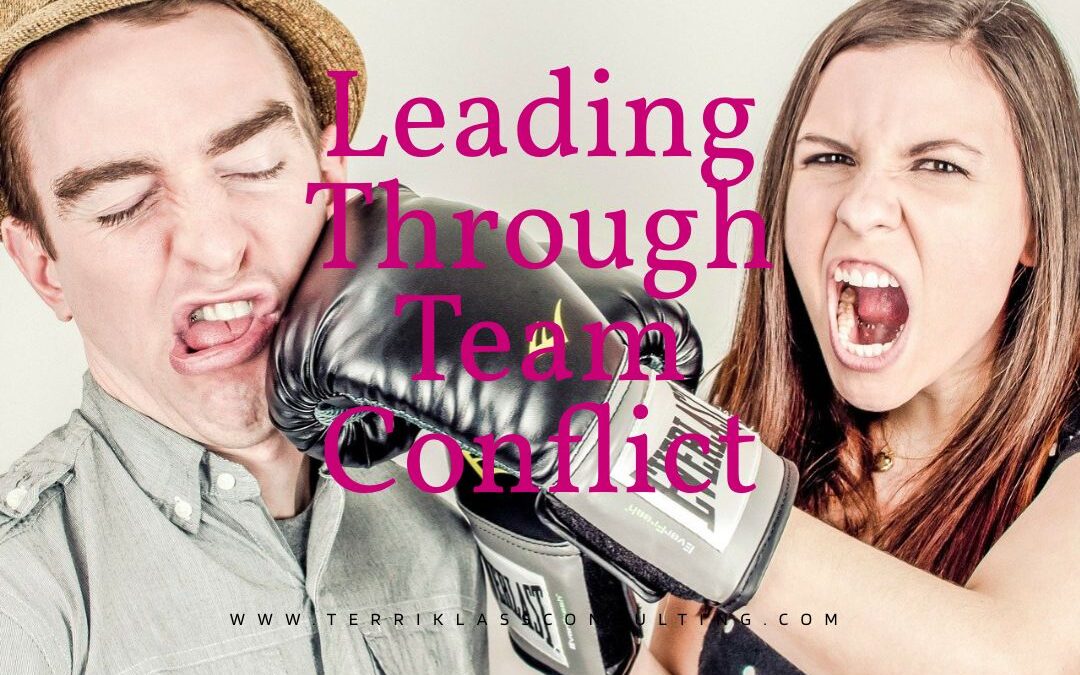Recently I was drawn into a heated discussion on a team I lead. The interaction took place so quickly that I barely realized what was happening until I had already been sucked in. Information and data were being thrown at me, leaving little room for me to respond to the team’s concerns. Some of the facts and data seemed possible, yet I intuitively knew that there were missing pieces.
Have you ever felt blindsided or pulled into a team conflict?
Were you concerned that you were not prepared to contribute your opinions in a meaningful way?
Did you wish you had all the critical facts and perspectives to respond in a more impactful way?
Conflict is part of team and organizational life and if handled well can lead to positive outcomes. However, when leaders are blindsided and do not anticipate conflict, they can be thrown off their game and not handle the conflict as successfully.
Here are five leadership steps to face team conflict:
1. Identify A Conflict Situation Accurately
It can challenging for leaders to accurately diagnose the truth about a conflict situation happening on the team when they are unaware of what’s involved. So most importantly, when we are faced with a conflict make sure to understand its nature and define it properly. Unless a leader possesses clarity of the conflict it will never be resolved in the best way.
When leaders face a conflict with their team members, clearly defining the conflict is critical. Share on X2. Do Not Allow Yourself to Be Rushed
Although a leader may want to put the conflict to rest or even lessen its value as quickly as possible, it may take time to resolve the issues. So, the greatest gift to give a leader facing a challenging scenario, is to repeat the mantra- “This is no need to rush”. Some benefits to taking your time are:
- There will be less of a chance of resolving the wrong conflict.
- Processing the information usually leads to far greater results.
- Time can often present new and essential information that wasn’t initially available.
3. Collect The Facts Carefully
There is nothing worse than leading through a conflict situation and not having all the necessary data to find a good solution. In my case, I did not have all the data and as a result could not connect the dots. Oftentimes leaders are faced with only partial facts from one side of the conflict. The next step is collecting and analyzing information from all sides to gain a complete picture.
When resolving conflict, leaders need to collect all the facts before rushing to a solution. Share on X4. Connect With the Stakeholders Involved
At the heart of conflict are the people involved directly and indirectly. What does that mean? That means we cannot lead without consulting the stakeholders. If leaders leave this step out:
- There will most certainly be missing information.
- The final resolution will probably be unacceptable.
- There will never be complete buy-in or commitment from everyone.
5. Respond With Calmness, Commitment and Clarity
With all team conflict resolution leaders owe it to themselves and their team members to not become overly frustrated or angry. When a leader “loses it” the whole ship goes down with them. A better and more impactful approach would be for a leader to keep breathing, keep perspective, delve into the facts with purpose and open-mindedness and prepare a clear response. In addition, when a leader shares their decision on how they suggest handling the conflict they need to be clear and concise, explaining how and why they reached a particular conclusion.
How have you led through a conflict team situation? What additional strategies have you found helpful to resolve team conflict?


I’ve also been in situations where info and data were thrown around before I had a chance to sit down and sort through what was truth, hyperbole, and outright lies. At first my confidence was shaken because I thought I should be able to drill down and instantly sort fact from fiction. It’s not easy, though, when different agendas compete for money or attention. I really like your emphasis on “clarity on the topic” for leaders and managers before they jump in with a comment or opinion. Great article, Terri!
It really can shake our confidence when we are being asked to respond to a conflict that we may be missing important information and facts. Clarity on what is happening is key, otherwise, we may end up finding a solution to a different conflict situation. Competing needs from different stakeholders can sometimes make the issues even more divided. We just should not be forced into a quick resolution until we are ready.
Thanks LaRae!